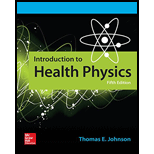
Concept explainers
A 50-µC/kg (approximately 200 mR) pocket dosimeter with air-equivalent walls has a sensitive volume with the dimensions in. (diameter) and 2.5 in. (length); the volume is filled with air at atmospheric pressure. The capacitance of the dosimeter is 10 pF. If 200 V are required to charge the chamber, what is the voltage across the chamber when it reads
The voltage across the chamber when it reads 50 µC/kg
Answer to Problem 6.1P
The voltage across the chamber when it reads 50 µC/kg is 150.755 V
Explanation of Solution
Given info:
Diameter, D = 0.5 in
Length, L = 2.5 in
Capacitance, C = 10 pF
Initial Voltage,
Formula used:
To calculate volume of the chamber, use the formula as
Calculation:
First convert the unit from ‘in’ to ‘cm’.
We know, 1 in = 2.54 cm
So, L = 2.5 in = 2.5 × 2.54 cm = 6.35 cm
Also, D = 0.5 in,
Substitute the values in equation (1), we get
Also given that,
Or,
To calculate mass (m), use the relation
Or,
Since, volume is filled with air,
Substitute the values in equation (2), we get
Now, to calculate final voltage use the relation
Substitute the values, we get
Conclusion:
Thus, the voltage across the chamber when it reads 50µC/kg is 150.755V
Want to see more full solutions like this?
Chapter 6 Solutions
Introduction To Health Physics
Additional Science Textbook Solutions
Introductory Chemistry (6th Edition)
Applications and Investigations in Earth Science (9th Edition)
Essentials of Human Anatomy & Physiology (12th Edition)
Human Physiology: An Integrated Approach (8th Edition)
Anatomy & Physiology (6th Edition)
 Physics for Scientists and Engineers: Foundations...PhysicsISBN:9781133939146Author:Katz, Debora M.Publisher:Cengage Learning
Physics for Scientists and Engineers: Foundations...PhysicsISBN:9781133939146Author:Katz, Debora M.Publisher:Cengage Learning Principles of Physics: A Calculus-Based TextPhysicsISBN:9781133104261Author:Raymond A. Serway, John W. JewettPublisher:Cengage Learning
Principles of Physics: A Calculus-Based TextPhysicsISBN:9781133104261Author:Raymond A. Serway, John W. JewettPublisher:Cengage Learning Physics for Scientists and Engineers with Modern ...PhysicsISBN:9781337553292Author:Raymond A. Serway, John W. JewettPublisher:Cengage Learning
Physics for Scientists and Engineers with Modern ...PhysicsISBN:9781337553292Author:Raymond A. Serway, John W. JewettPublisher:Cengage Learning An Introduction to Physical SciencePhysicsISBN:9781305079137Author:James Shipman, Jerry D. Wilson, Charles A. Higgins, Omar TorresPublisher:Cengage Learning
An Introduction to Physical SciencePhysicsISBN:9781305079137Author:James Shipman, Jerry D. Wilson, Charles A. Higgins, Omar TorresPublisher:Cengage Learning College PhysicsPhysicsISBN:9781938168000Author:Paul Peter Urone, Roger HinrichsPublisher:OpenStax College
College PhysicsPhysicsISBN:9781938168000Author:Paul Peter Urone, Roger HinrichsPublisher:OpenStax College Glencoe Physics: Principles and Problems, Student...PhysicsISBN:9780078807213Author:Paul W. ZitzewitzPublisher:Glencoe/McGraw-Hill
Glencoe Physics: Principles and Problems, Student...PhysicsISBN:9780078807213Author:Paul W. ZitzewitzPublisher:Glencoe/McGraw-Hill





